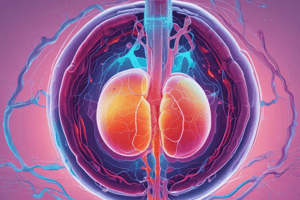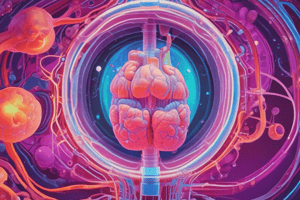Podcast
Questions and Answers
What is the purpose of radionuclides being chemically incorporated into another compound and injected into the body?
What is the purpose of radionuclides being chemically incorporated into another compound and injected into the body?
- To act as a treatment for tumors
- To emit only gamma radiation
- To induce cellular changes in the body
- For diagnostic imaging purposes (correct)
What is the main reason for choosing suitable radionuclides for nuclear imaging?
What is the main reason for choosing suitable radionuclides for nuclear imaging?
- To simplify the detection process for medical professionals
- To reduce patient costs for imaging procedures
- To minimize radiation effects on the body tissues (correct)
- To increase the half-life of the radioisotope
What characteristics must radionuclides for radiopharmaceuticals possess?
What characteristics must radionuclides for radiopharmaceuticals possess?
- Long half-life and minimal absorption in body tissue
- High cost and easy availability
- Readily attachable to transport compounds and low energy emission (correct)
- Decay via photon emission and minimal short-lived activity
What is the purpose of radionuclide generators in the context of medical imaging?
What is the purpose of radionuclide generators in the context of medical imaging?
Why are short-lived radionuclides often the agents of choice for nuclear imaging?
Why are short-lived radionuclides often the agents of choice for nuclear imaging?
What term is used to describe an atom with excess nuclear energy, making it unstable?
What term is used to describe an atom with excess nuclear energy, making it unstable?
Which of the following is NOT a way in which the excess energy of a radionuclide can be used?
Which of the following is NOT a way in which the excess energy of a radionuclide can be used?
Which type of radiation is considered ionizing because it is powerful enough to free an electron from another atom?
Which type of radiation is considered ionizing because it is powerful enough to free an electron from another atom?
In which of the following locations can radionuclides be artificially produced?
In which of the following locations can radionuclides be artificially produced?
What is a pharmaceutical drug made with radionuclides called?
What is a pharmaceutical drug made with radionuclides called?
Flashcards are hidden until you start studying
Study Notes
Radionuclides in Nuclear Imaging
- Radionuclides are chemically incorporated into another compound and injected into the body to allow for visualization of internal structures and functions through nuclear imaging.
Selection of Radionuclides
- The main reason for choosing suitable radionuclides is that they emit radiation at a rate and energy suitable for detection and imaging.
Characteristics of Radionuclides
- Radionuclides for radiopharmaceuticals must possess the following characteristics:
- Emits radiation at a suitable energy and rate
- Has a suitable half-life
- Can be chemically incorporated into a compound
- Is tolerated by the body
Radionuclide Generators
- Radionuclide generators are used to produce short-lived radionuclides that are not feasible to produce through other means, and are used to provide a constant supply of radionuclides for medical imaging.
Advantages of Short-Lived Radionuclides
- Short-lived radionuclides are often the agents of choice for nuclear imaging because they expose patients to lower radiation doses and reduce the risk of radioactive waste.
Radionuclide Definition
- An atom with excess nuclear energy, making it unstable, is called a radionuclide.
Energy Release
- Excess energy of a radionuclide can be used in the following ways:
- Emitting radiation
- Heating a material
- Producing electricity
- Not: boiling water
Ionizing Radiation
- Ionizing radiation is considered powerful enough to free an electron from another atom, and includes alpha, beta, and gamma radiation.
Artificial Production of Radionuclides
- Radionuclides can be artificially produced in:
- Nuclear reactors
- Particle accelerators
Radiopharmaceuticals
- A pharmaceutical drug made with radionuclides is called a radiopharmaceutical.
Studying That Suits You
Use AI to generate personalized quizzes and flashcards to suit your learning preferences.




